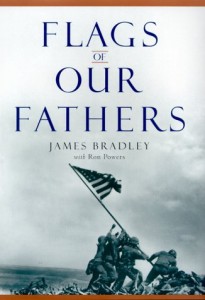26 Jan Flags of our Fathers
(2006) To me “World War II” has always brought two images to mind: Hitler and concentration camps. When I was a little girl, our parents had a series of books about the war with lots of photographs (similar to Time-Life books.) I would pore over pictures taken in the war camps and think, of course … now this is why our country fought this war. I just never gave the same level of attention to the war in the Pacific.
After listening to The War and better appreciating the extent of the battles on both sides of the world, this morning I drove back to Atlanta from Columbia, SC and started to listen to the audio book Flags of our Fathers by James Bradley. After his father died, James found a stack of boxes with papers, pictures, and letters. His Dad had been at Iwo Jima and was one of the flag raisers in the famous photograph by Joe Rosenthal — which may be the most reproduced photograph ever. James’ Dad told his wife on their first date that he had been at Iwo Jima but then barely spoke of it again in 40+ years of marriage. By this time, I was hanging on every word.
I am over half way through. As I listened to James Bradley describe what happened there, I couldn’t help but cry. I didn’t want to stop the car for fear someone might ask if I was okay. Until this year, I could hardly watch a serious war movie. As the mother of two sons, it was unbearable to see the violence, the death. Now I want to watch the movie based on this book … it came out in 2006 and was produced by Steven Spielberg and directed by Clint Eastwood.
This film clip about the flag raising at Iwo Jima was interesting. During the war, everyone got the bulk of their news from the radio, the newspapers or news clips at the movie theaters. This newscast doesn’t describe how brutal the fighting really was. The flag raising was on Day 5 of the battle. It went on for another month. Iwo Jima Newsclip
Am I getting off track? I don’t think so. Learning more about the entire scope of the war is helping me better understand what our parents were hearing and thinking and experiencing, particularly during 1944 and 1945. The battle in Iwo Jima began on February 19, 1945. My parents had been married for barely a month … Herman had returned to the United States and orders were that he would next go to the Pacific …
We can never honor our veterans enough.
Flags of Our Fathers at amazon.com



Rowdy
Posted at 17:42h, 22 MayThis story brings a tear to my eye also. Two things in it draw my attention…one, is the depiction of the callousness of the politicians back home; and two, that Bradley never knew that his father had received the Navy Cross until he found the medal amongst his father’s things after he had passed away. The Navy Cross is the country’s second highest recognition for valor, ranking just below the CMOH.
Actions leading to the award of one of these valor decorations are never planned. The recipients of them often find it difficult to rationalize why they were singled out for the award when there were so many others around him who were also doing “their job”. They are often awarded posthumously.
Doing “their job.” That is how most heroes describe what they did, when at a certain moment, they were singled out for heroic recognition. Truth is, so many of them were heroes every day. And in a nutshell, that is why so many heroes with a medal had a problem resolving why they were singled out.
I’ve found a couple of interesting observations that were made by WWII AAF veterans when providing their evaluation of the medals they saw on various WWII vintage chests…One said that when he saw a Distinguished Flying Cross on a uniform, it meant that the man had made 25-30 missions over dangerous targets like Berlin or Schweinfurt where the loss rates could be almost 50%; and two, that he always disregarded any medal ranked higher than a DFC when worn by a senior officer, unless it was accompanied by a Purple Heart. That simply meant that not all medals were properly earned.
In your father’s case, since he made but 12 missions, he would likely have qualified for only one Air Medal, which were awarded at a rate of one per 7 missions. If he was injured, then he may have been awarded a Purple Heart; otherwise, he would have qualified for what the soldiers referred to as “show up” medals, meaning that everyone that showed up got one…those were the American Campaign, the ETO, and a WWII Victory Medal. Although, the men themselves tended to downplay those medals, the qualification for receiving them was significant–they had to show up and perform duties as required–not an insignificant thing.
In some respects those who were shot down were short changed in terms of military recognition. Since they didn’t complete a tour, they failed to qualify for a DFC (which was awarded for each completed tour of duty–there were something like 41,000 of them awarded during WWII), and depending on how many missions they did fly, many didn’t qualify for an Air Medal either. Former POW’s, I think, tended to feel somewhat alienated from those who completed their tours, perhaps because of this.
The 447th had one recipient of the CMOH, a young navigator. He died just after landing back at his base following his sixth (I, think) mission, so he didn’t qualify for even one Air Medal. Since he didn’t complete a tour, he didn’t qualify for a DFC. The 23-year old navigator’s medals were: CMOH, Purple Heart, and the “show up” medals…all of them awarded posthumously. He never saw any of them.